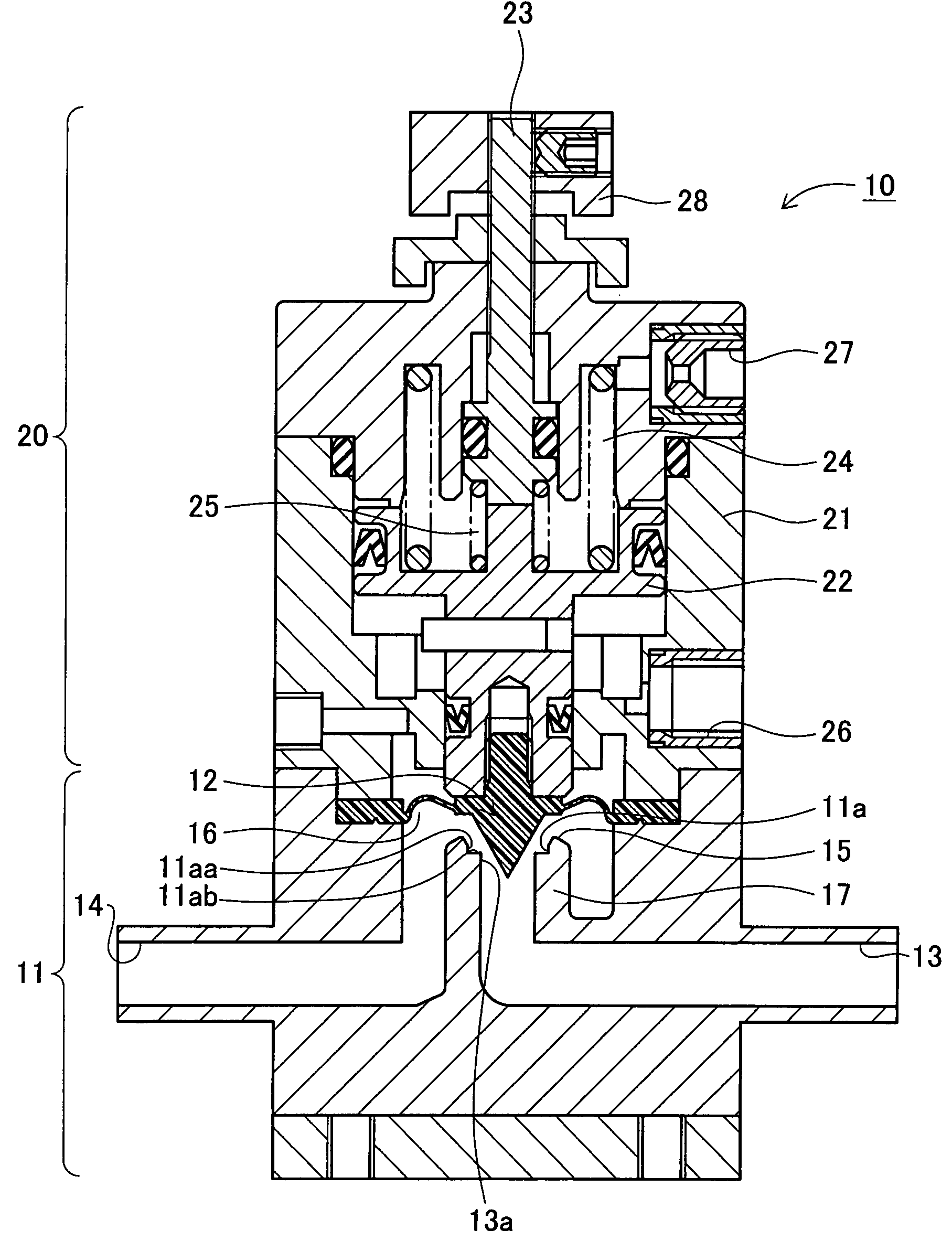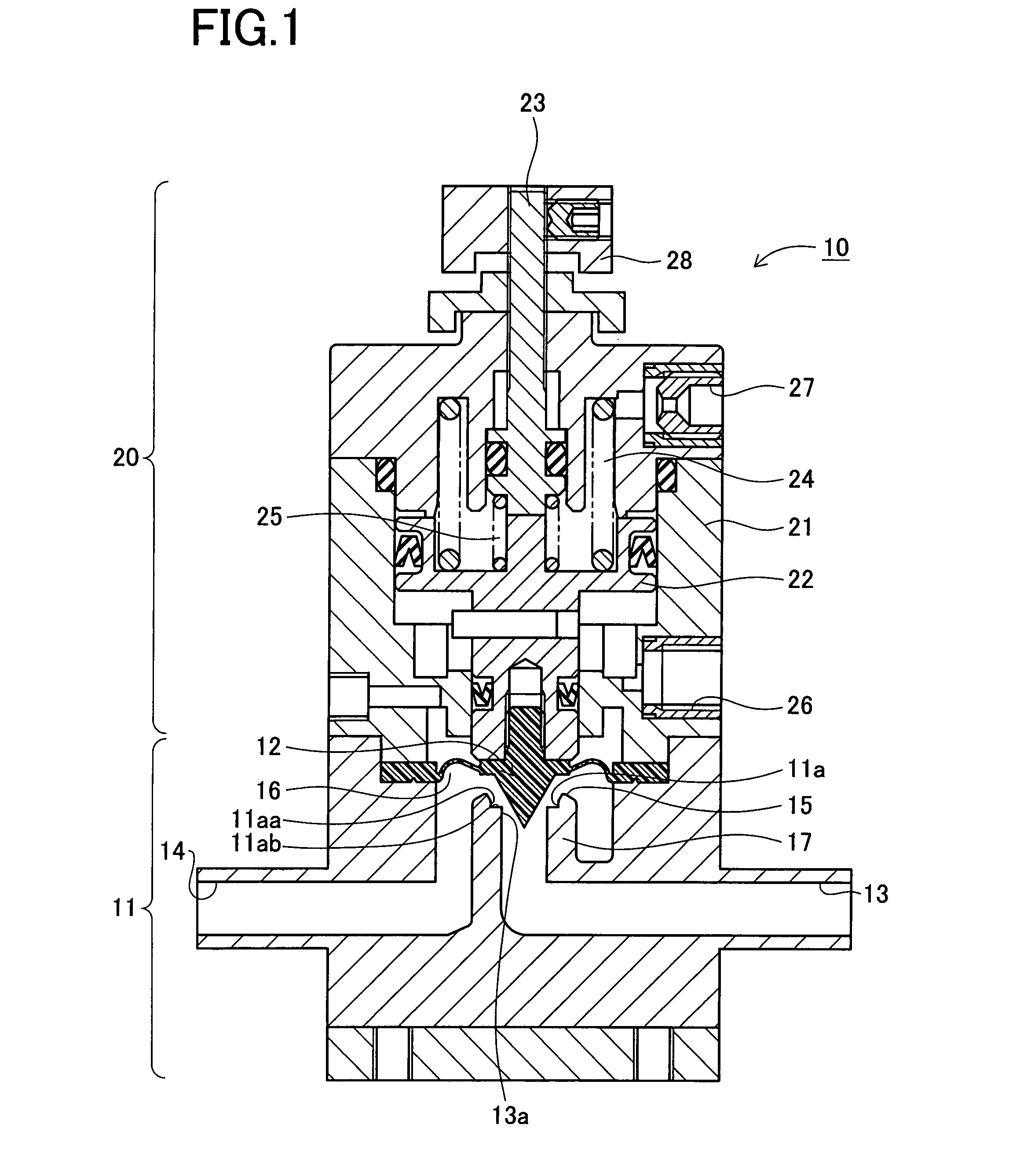Flow control valve
a flow control and valve seat technology, applied in the direction of diaphragm valves, valve housings, engine diaphragms, etc., can solve the problems of gradual deformation or creep of the valve seat, and achieve the effect of improving flow stability, reducing the size of the facility, and improving flow stability
- Summary
- Abstract
- Description
- Claims
- Application Information
AI Technical Summary
Benefits of technology
Problems solved by technology
Method used
Image
Examples
first embodiment
[0062]FIG. 1 is a sectional view of a flow control valve of the first embodiment, showing a valve open state. The flow control valve 10 comprises a body section 11 and an operation section 20. The body section 11 is made of resin such as PFA, which is highly resistant to chemicals. Please note that in the figures the resin body section 11 and a resin actuator body 21 mentioned later are indicated by single cross-hatching generally used for a metal section for easy viewing.
[0063]The body section 11 is provided with a first passage 13, a second passage 14, a valve seat 15, and a valve chamber 16. The first passage 13 is allowed to communicate with the valve chamber 16 through a valve port 13a and communicate with the second passage 14 communicating with the valve chamber 16 for permitting a chemical or another fluid to pass therethrough. The first passage 13 is formed in a cylindrical part 17, at the top of which the annular valve seat 15 is provided around the valve port 13a.
[0064]I...
second embodiment
[0128]A second embodiment of the present invention will be described below. The configuration of the second embodiment is substantially identical to that of the first embodiment. The following explanation is therefore made with a focus on a difference from the first embodiment.
[0129]The difference is the shape of an annular recess 11a, which is shown in FIGS. 7 and 8. FIG. 7 is an enlarged sectional view of a valve seat and its surrounding portion in a flow control valve of the second embodiment, showing a valve closed state. FIG. 8 is an enlarged sectional view of the valve seat and its surrounding portion in the flow control valve of the second embodiment, showing an opened state.
[0130]As shown in FIGS. 7 and 8, the annular recess 11a is of a sectional shape formed by cutting away a portion of the valve seat 15 at a slant, providing two different angled surfaces (an upper side surface 11aa and a lower side surface 11ab) joined at an obtuse angle, instead of the two surfaces (the v...
third embodiment
[0142]A third embodiment of the present invention will be described below.
[0143]The construction of the third embodiment is substantially identical to that of the first embodiment. The following explanation is therefore made with a focus on a difference from the first embodiment.
[0144]FIG. 9 is an enlarged sectional view of a valve seat and its surrounding portion in a flow control valve of the third embodiment, showing a valve closed state. FIG. 10 is an enlarged sectional view of the valve seat and its surrounding portion in the flow control valve of the third embodiment, showing a valve open state.
[0145]The difference is the shape of a needle 12a of a valve element 12. The needle 12a of the third embodiment is formed in a cylindrical shape having a lower tapered surface for controlling a flow rate.
[0146]Specifically, the needle 12a includes a cylindrical portion 12aa and a tapered portion 12ab. The cylindrical portion 12aa has a diameter smaller than the inner diameter of the val...
PUM
 Login to View More
Login to View More Abstract
Description
Claims
Application Information
 Login to View More
Login to View More - R&D
- Intellectual Property
- Life Sciences
- Materials
- Tech Scout
- Unparalleled Data Quality
- Higher Quality Content
- 60% Fewer Hallucinations
Browse by: Latest US Patents, China's latest patents, Technical Efficacy Thesaurus, Application Domain, Technology Topic, Popular Technical Reports.
© 2025 PatSnap. All rights reserved.Legal|Privacy policy|Modern Slavery Act Transparency Statement|Sitemap|About US| Contact US: help@patsnap.com



